Seagate Backup Plus Portable 5TB & Backup Plus Slim 2TB Review: SMR for the Consumer Market
by Ganesh T S on June 18, 2019 8:00 AM ESTInvestigating SMR for Consumer Workloads
The nature of the platters in a hard drive (CMR or SMR), unless explicitly mentioned, is not immediately evident from the specifications or even artificial benchmark tests that use a small work set. Even replaying real-world work traces often only provides slight hints about the presence of SMR. Our first tryst with SMR in the lab was the 8TB Seagate Archive HDD, followed by the retail-focused Seagate Innov8. While the Archive HDD (one of the first SMR drives from Seagate that went into mass production) had dismal performance consistency, the Innov8 carried substantially improved firmware that enabled much better overall performance numbers. With the passage of time, Seagate has improved the firmware to such an extent that the tests detailed in the link above can no longer reliably detect the presence of SMR in a drive.
Detecting SMR - The Sequential Writes Test
One of the tests we have recently started doing on flash-based storage devices is performance consistency under extremely stressful sequential write workloads. The fio workload used for this purpose was adapted for running on the external hard drives. This 128K sequential write workload was set to span the entire capacity of the drive. First off, we take a look at the processing of this workload on a CMR drive - the WD My Passport 4TB.
We see the bandwidth numbers between 90 MBps and 110 MBps as we start off at the outer edge of the platters. We see a gradual steady drop down to 50-70 MBps as we move towards the center. This drop (based on the sector location in the drive's platters) is a well-known phenomenon due to the presence of a larger number of sectors on a per-revolution basis as we move further away from the center of the platter.
The Seagate Backup Plus Slim, on the other hand, starts off between 125 and 135 MBps and ends up between 60 and 80 MBps. Worryingly, we have drops down to 10 MBps frequently. It can be seen that the firmware tries to avoid these slow write scenarios as much as possible (almost a hour of sustained sequential writes), but, the amount of traditional PMR space in the platters eventually runs out and the drive is forced to record to the shingled space. This results in the drop of the instantaneous write rates to 10 MBps periodically.
The same behavior is seen in the Seagate Backup Plus Portable 5TB drive also.
The 5TB drive is actually able to avoid writing to the SMR space for more than 90 minutes before yielding to the inevitable.
Backing up System Images - A Real World Test
Sustained sequential writes for a hour or more are not realistic workloads for a majority of the retail consumers. However, it must be noted that the drop in transfer rates may start to happen after all the non-shingled areas are already filled with data. Thus, once the SMR drive is, say 20 - 25% full, it is likely that users will see considerably worse performance compared to a fresh drive. To test this, we brought back the LaCie Porsche Design Mobile 4TB (also a SMR drive) and filled it to around 14% of the capacity with system images of different PCs created using the System Image Backup native utility in Windows. The same data was also used to put the other hard drives in the 'used' state.
A system image of the testbed was then taken on the extrnal drive, while the read and write transfer rates to the drive were monitored.
The WD My Passport 4TB shows the system image write out being consistently between 70 MBps and 110 MBps. In contrast, the Porsche Design Mobile drive (of the same capacity) had frequent dips to around 20 MBps. The peaks were higher at 130 MBps. Despite the higher peaks, the LaCie Porsche Design Mobile took more time compared to the WD My Passport for recording the system image.
Graphs for the same scenario involving the Backup Plus Slim and Backup Plus portable show that the SMR issue is still exposed. However, the valleys are spread much farther apart compared to the LaCie Porsche Design Mobile from a couple of years back.
SMR drives do show higher peak performance numbers compared to CMR drives with the same capacity. However, the lack of performance consistency means that a CMR drive is a more predicable medium for typical consumer workloads in the long run.


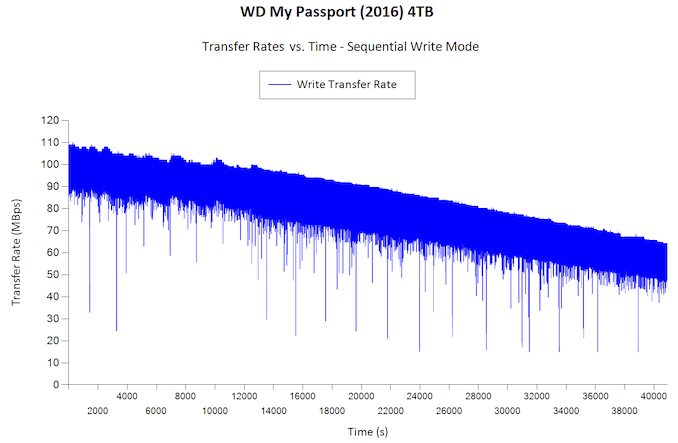


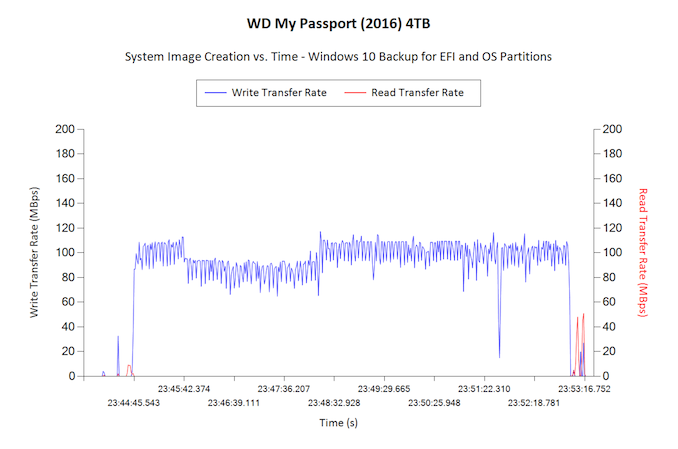
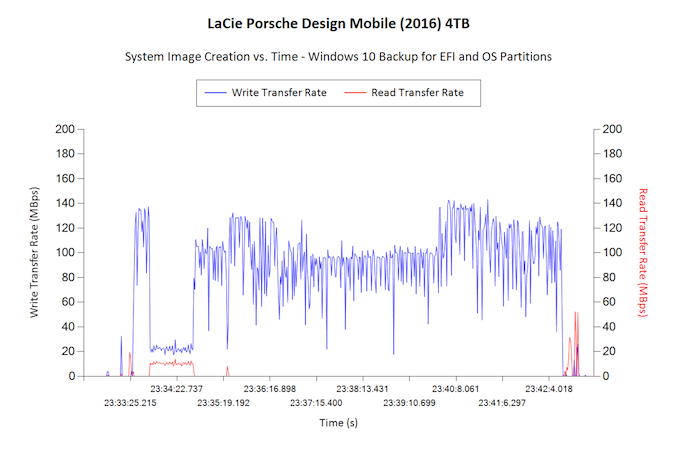
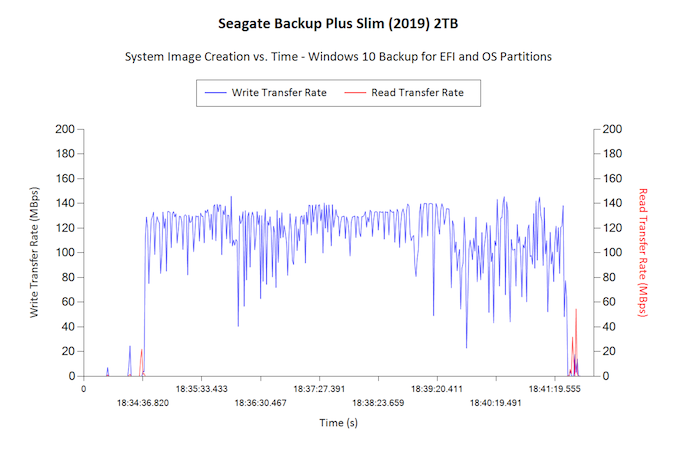
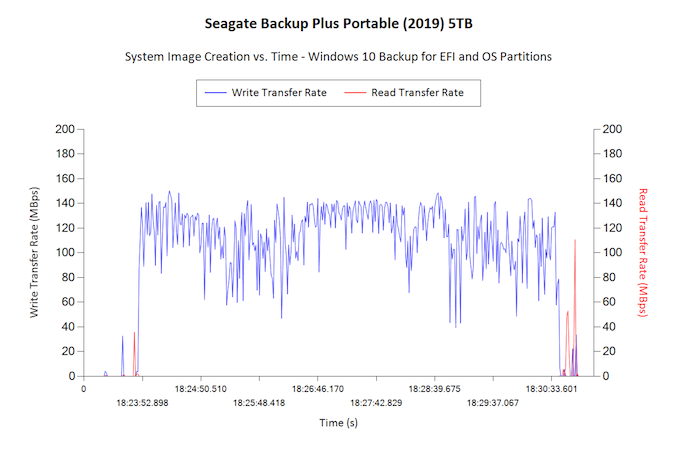








62 Comments
View All Comments
sheh - Tuesday, June 18, 2019 - link
Seagate's had a few bad 4TB models. ST4000DM001, and maybe DM005 and DX001. Models like DM000 seem better:https://www.backblaze.com/blog/hard-drive-stats-fo...
https://www.backblaze.com/blog/hard-drive-stats-fo...
sheh - Tuesday, June 18, 2019 - link
(This was a reply to oRAirwolf. Anandtech's commenting system fails to create a sub-comment without Javascript.)sheh - Tuesday, June 18, 2019 - link
22 hours to write the whole 5TB drive?!abufrejoval - Wednesday, June 19, 2019 - link
I am a little surprised, that a consistent sequential write to an SMR should drop the data rate below a non-shingled drive. AFAIK only updates-in-place of a shingle should trigger the SMR write-amplification, unless the firmware actually always writes to a none-shingled section of the drive first, similar to an SLC buffer on TLC/QLC SSDs. That seems to happen with the fio workload, but not with the backup: Otherwise its performance would have to drop similarly.I guess that is where SMRs would have a command set which allows applications to steer that behavior by hinting how data should be handled. And perhaps they should support a variant of TRIM, by which an OS could signal, which parts of a shingle no longer need preservation and avoid the write amplification.
The problem is that without some low-level tool as a user you currently don't really have control over an SMR drive's behavior. The OS could/would/should know perhaps, that the large set of files you are copying are in fact intended to replace your last backup, but at the block level of a drive, without some help from the OS or a hint via a tool all that useful information is lost and the firmware needs to second guess your intentions.
I don't think I have heard of any SMR specific optimizations on Windows, and to be honest not even on Linux. And then this isn't just OS but also file system specific and AFAIK exFAT isn't known for its sophistication.
In any case I'd expect your experience to vary over the life-time of the drive. First time you fill it, it might be ok enough, but once you're into incremental backups replacing smallish files at near medium capacity, the 25% capacity increase may turn out too expensive in extra time.
If you're doing full backups only, erasing first might help. But only, if there is a way to tell the drive that entire shingles don't need preservation.
Kastriot - Wednesday, June 19, 2019 - link
Pricing for 5TB model is very tempting.ballsystemlord - Wednesday, June 19, 2019 - link
Only one grammar error, good work Ganesh!"Sustained sequential writes for a hour or more are not realistic workloads for a majority of the retail consumers."
"an" not "a" (Yes, its an English idiosyncrasy, not the typical "an" before vowel "a" before consonent):
"Sustained sequential writes for an hour or more are not realistic workloads for a majority of the retail consumers."
ballsystemlord - Wednesday, June 19, 2019 - link
*consonantaustonia - Monday, June 24, 2019 - link
The 5TB drives are often $95 or $100 at Costco. I have half dozen, they work fine.badbanana - Tuesday, June 25, 2019 - link
for those using such devices for backup, over time the files stored in this external HDDs would fail eventually (according to my findings). therefore i make sure to have another backup somewhere, like the cloud, to ensure that the files will be readable in the coming years. that's my plan B.for the rest of you, what are your plan Bs?
Chloiber - Saturday, June 29, 2019 - link
Interesting read, thanks!We often use external hard disks from WD to create archives of certain datasets (usually very large, single files) and had to use the 5TB Seagate version for the first time as we exceeded 4TB.
I did notice that it took very long for the copy - I don't think I have kept the logs, but this would explain a lot!